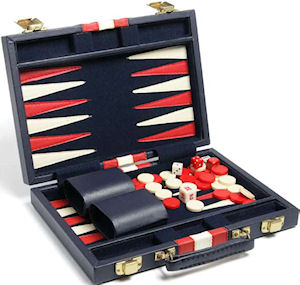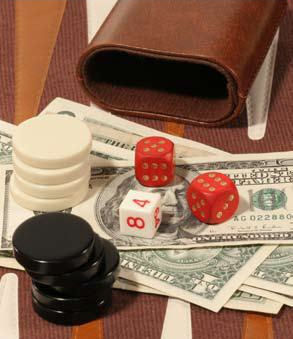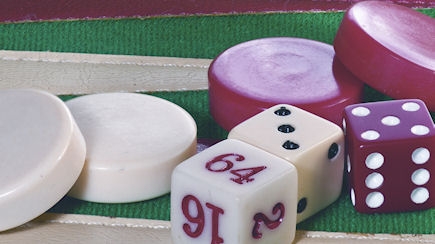This article first appeared in the Nov/Dec 2010 issue of World Gaming magazine.
In the last two issues of World Gaming we discussed the history and rules of this wonderful game. Now we’re going to cover the rules and practices surrounding betting on the ancient game of backgammon.
There are some games and mind sports that gamblers just seem to love to play. Amongst these are games like darts, and the cue sports such as billiards, pool, snooker and 9-ball. It is often said the participation crossover between poker and pool is around 90 per cent. Backgammon is another of these games that gamblers love to play. You’ll often see a backgammon set in casino VIP lounges or card clubs, and many poker players love to claim they’re backgammon experts – and some of them really are! Almost all experienced gamers have at least a working knowledge of how to bet at backgammon, and now with the advent of backgammon on the internet you can always get a game online: 24 hours a day, 7 days a week!
Board points and scoring points
You’ll remember from our last backgammon article the aim of the game is to race your 15 counters around the board from your 24-point towards your 1-point and then bear them off (or remove them) from the board. The first player to bear off all his 15 counters wins.
Remember the entire board is split into four smaller ‘boards’ of six points each: your home board, your outer board, your opponent’s outer board and finally your opponent’s home board. Your home board consists of your 24-point (his 1-point) down to your 19-point (his 6-point) and your opponent’s home board consists of your 6-point (his 19-point) down to your 1-point (his 24-point).
Scoring and betting in backgammon also involves ‘points’, but these are scoring points, a different type of ‘point’ to the ‘points’ on the board. In order to avoid confusion you can think of the points on the board as ‘board points’ and the points you win from winning games as ‘scoring points’. It is the scoring points that result in you winning money!
Backgammon is always played for a certain amount of money ‘per (scoring) point’. It might be $1 a point, it might be $25 a point, and it might even be $100 a point. As with all gaming, the stakes are up to the players.

Gammons and Backgammons
Usually, when the winning player bears off his fifteenth and last counter, his opponent has already born off at least some counters too. This case is called a ‘single win’, and counts as one point. But sometimes, the losing player still hasn’t born off any of his counters at all (his entire set of 15 counters are still in play). This case is called a ‘gammon’ and the winning player wins double: 2 points. If the winning player has done so well that his opponent still has at least one counter on the bar or languishing back in the losing player’s home board, this is called a ‘backgammon’ and counts as a triple win: 3 points.
No, the ‘bar’ is not a place you go to buy a drink! If you’ve forgotten what the ‘bar’ is go to our website and check out our article Backgammon: The Basics in our Sep/Oct 2010 issue.
The doubling cube
At the start of the 20th century a Russian noble, the Grand Duke Dmitri, invented the doubling cube. It is thought he probably invented it so that he could win more money of his unsuspecting rich friends! Whatever the reason, the doubling cube certainly revolutionised the way people bet on backgammon.
The doubling cube looks like a big die, but the difference is that instead of having one to six pips on each surface, it has a different number on each side. Those numbers are 2, 4, 8, 16, 32 and 64. At the start of the game no one is in possession of the cube and it sits on the bar, between the players. This state is often called ‘centred on 1’ and it means that the game is being played at normal (or single) stakes. Because there is no number 1 on the cube, when the cube is ‘centred on 1’ it shows the number 64.
At any point during a game being played at single stakes, either player can offer the cube to the other player. This offer is an offer to double the stakes of the game, from single stakes to double stakes. The person that is offered the cube has two options. He can decline the offer, which immediately resigns the game for a score of one point; or he can accept the cube, thus doubling the stakes to two points, and play on. Once he accepts the cube it is turned to show the number ‘2’ on top (indicating the game is now being played at double stakes), and the acceptor of the cube is now in possession of it.

Once the cube has been offered and accepted once in a game, it is always in the possession of one of the two players (it can never return to being in the middle as it was at the start of the game). Once the cube gets in one of the players’ possession, only the possessor of the cube can offer it to the other player. The cube can be offered and accepted an unlimited number of times, passing back and forth between the two players. From double stakes the game could theoretically go to quadruple stakes, then 8-times stakes, 16-times stakes, and so on. In practice it is very rare for the stakes to get this high, as that should only occur if strong favouritism to win the game swung back and forth violently between the two players many times throughout the game.
Gammons and backgammons still count toward the final result, in addition to any action on the doubling cube. For example, if the doubling cube has been offered and accepted twice in a game, it is now being played for quadruple (or 4-times) stakes. If you win a gammon you will win 8 points. A backgammon will win you 12 points!
In upcoming backgammon articles, we’ll explain the ‘Jacoby rule’ and what a beaver and a racoon are (no they are not furry animals!) We’ll also teach you the optimal strategy for offering the doubling cube, and if offered the cube, for accepting it.







